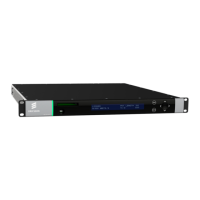Using the Equipment
Marketing Code Description FAZ Number License Key Name
RX8200/SWO/HDSDI/3G MPEG-4 HD 4:2:2
1080p 50/60
Decoding
FAZ 101 0113/34 RX8200/SWO/HDSDI/3G
3.13.3.5 Functional Description
Contribution of 4K UHDTV is possible by utilizing Ericsson AVP 2000 Encoders and
RX8200 IRDs. The 4K picture is split in to four 1920x1080 quadrants and encoded
by the AVP2000 encoders to produce a 4 Service MPTS that can then be
transmitted.
At the next stage four RX8200 IRDs are required for decoding, one for each
quadrant. Each IRD will output a 3G-SDI signal.
These four 3G-SDI signals need to be recombined to produce the 4K image. Some
monitors may perform this internally. For others 3rd party equipment must be used
to create the required format signal.
For a more detailed explanation of Ericsson’s 4K contribution solution, please
contact Ericsson Customer Services.
3.13.3.6 4K Configuration
The four IRDs must be identical in terms of hardware, software and licenses. Only
the second and third generation Decoder 4:2:2 cards are capable of performing the
MPEG-4 AVC 1080p decode requires for each quadrant.
The necessary licenses are listed in section 3.13.3.4
A recommended configuration is shown in the following table and figure.
Table 3.16 RX8200 4K Configuration
RX8200 Designation Quadrant Comment
RX 1 Master IRD Q1 Quadrant one is the 4K Upper Left quadrant
RX 2 Slave IRD Q2 Quadrant two is the 4K Lower Left quadrant
RX 3 Slave IRD Q3 Quadrant three is the 4K Upper Right
quadrant
RX 4 Slave IRD Q4 Quadrant four is the 4K Lower Right quadrant
RX 1 is configured as the Master IRD and used as the synchronization source for
RX 2, 3 and 4 which are the Slave IRDs. This is done by taking the CVBS output
from the Master IRD into an analogue distribution amplifier which is then used to
feed the Frame Sync inputs for each of the Slave IRDs.

